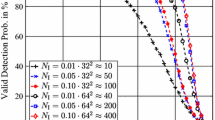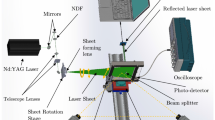Abstract
One approach to obtain information about the out-of-plane velocity component from PIV recordings is to analyze the height of the peak in the correlation plane. This value depends on the portion of paired particle images, which itself depends on the out-of-plane velocity component and on other parameters. To circumvent problems with other influences (e.g. background light, amount and size of images), images from another light sheet plane parallel to the first one were also captured for peak height normalization. Our experimental results show the feasibility of an out-of-plane velocity estimation by analyzing images of particles within parallel light sheets by spatial cross-correlation.
Similar content being viewed by others
Abbreviations
- C :
-
particle density in the flow
- d τ :
-
particle image diameter
- f 0, f 1 :
-
frames containing images of particles within the first light sheet at t=t 0 (frame f 0) and at t=t 0 + Δt (frame f 1)
- f 2 :
-
frame containing images of particles within the second light sheet parallel to the first one at t=t 0 + 2Δt
- F 1 :
-
estimator of the loss of image pairs due to in-plane motion
- F 0 :
-
estimator of the loss of image pairs due to out-plane motion
- F τ :
-
convolution of the particle image intensity distributions
- K :
-
factor containing constant parameters in the correlation plane
- M :
-
imaging magnification (image size/object size)
- n 0 :
-
number of particles in the measurement volume at t=t 0
- n 0,1 :
-
number of particle image pairs in interrogation windows of f 0 andf 1
- n 1,2 :
-
number of particle image pairs in interrogation windows off 1 and f 2
- O z :
-
overlap of the light sheets
- R C (s):
-
convolution of the mean intensity distributions
- R D (s):
-
correlation which gives the image displacement
- R F (s):
-
fluctuating noise component of the cross correlation estimator
- R 0,1(s D ):
-
cross-correlation peak height of interrogation windows off 0 and f 1
- R 1,2(s iuD):
-
cross-correlation peak height of interrogation windows of f 1 and f 2
- s :
-
two-dimensional separation vector in the correlation plane
- s D :
-
mean particle image displacement in the interrogation cell
- t e :
-
light pulse duration
- t f :
-
frame-transfer time of the video camera
- u :
-
three-dimensional local flow velocity vector (u,v,w)
- X i :
-
position of the center of an interrogation window in the image plane (2d)
- x i :
-
position of the center of an interrogation volume in the flow (3d)
- (z 2 — Z 1):
-
displacement of the light sheets in z-direction
- Δt :
-
separation time of the light pulses
- Δx 0 :
-
x-extension of an interrogation volume
- Δy 0 :
-
y-extension of an interrogation volume
- Δz 0 :
-
light sheet thickness
Reference
Adrian RJ (1988) Statistical properties of particle image velocimetry measurements in turbulent flows. In: Laser Anemometry in Fluid Mechanics III (ed. RJ Adrian, T Asanuma, DFG Durao, F Durst and JH Whitelaw): 115–129
Adrian RJ (1991) Particle-imaging techniques for experimental fluid mechanics. Ann Rev Fluid Mech 23: 261–304
Keane RD; Adrian RJ (1990) Optimization of particle image velocimeters. Part I: Double pulsed systems. Meas Sci Technol 1: 1202–1215
Keane RD; Adrian RJ (1992) Theory of cross-correlation analysis of PIV images. Appl Sci Res 49: 191–215
Liepmann D; Gharib M. (1992) The role of streamwise vorticity in the near field entrainment of round jets. J Fluid Mech 245: 643–668
Prasad AK; Adrian RJ (1992) Stereoscopic particle image velocimetry applied to liquid flows. 6 Int Symp on Appl of Laser Techniques to Fluid Mechanics, Lisbon, Portugal, paper 6-1
Raffel M; Kompenhans J (1994a) Error analysis for PIV recording utilizing image shifting. 7 Int Symp on Appl of Laser Techniques to Fluid Mechanics, Lisbon, Portugal, paper 35-5
Raffel M; Kompenhans J; Stasicki B; Bretthauer B; Meier GEA (1994b) Velocity measurement of compressible air flows utilizing a highspeed video camera. Exp Fluids 18: 204–206
Weigand A (1993) The response of a vortex ring to a transient, spatial cut. Dissertation University of California San Diego
Weigand A; Gharib M (1994) On the evolution of laminar vortex rings. Phys Fluids 7
Willert CE; Gharib M (1991) Digital particle image velocimetry. Exp Fluids 10: 181–193
Willert CE; Gharib M (1992) Three-dimensional particle imaging with a single camera. Exp Fluids 12: 353–358
Author information
Authors and Affiliations
Additional information
The authors would like to thank DLR for supporting Markus Raffel's and Olaf Ronneberger's visit to Caltech (Center for Quantitative Visualisation), and the Office of Naval Research through the URI grant ONR-URI-N00014-92-J-1610. Dr. Alexander Weigand's generous offer of his experimental set-up and stimulating discussions with Dr. Jerry Westerweel and Dr. Thomas Roesgen are greatly appreciated. Special thanks also to Dr. Christian Willert for his advice regarding the modifications to the DPIV software.
Rights and permissions
About this article
Cite this article
Gharib, M., Raffel, M., Ronneberger, O. et al. Feasibility study of three-dimensional PIV by correlating images of particles within parallel light sheet planes. Experiments in Fluids 19, 69–77 (1995). https://doi.org/10.1007/BF00193852
Received:
Accepted:
Issue Date:
DOI: https://doi.org/10.1007/BF00193852




